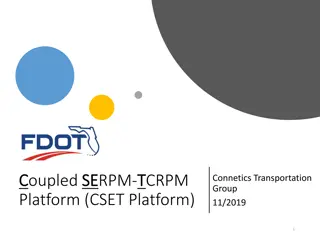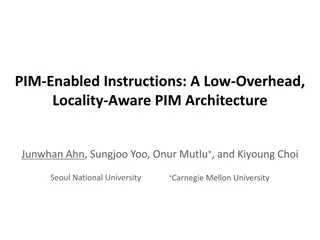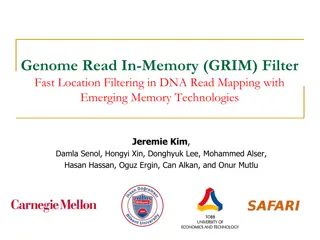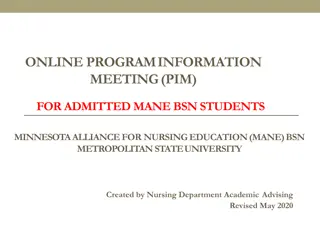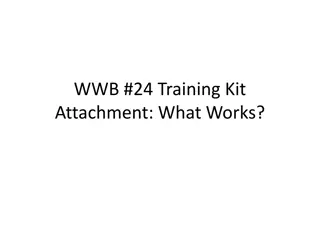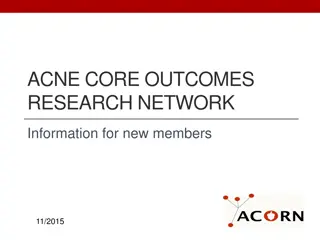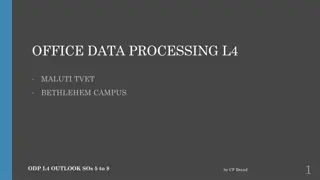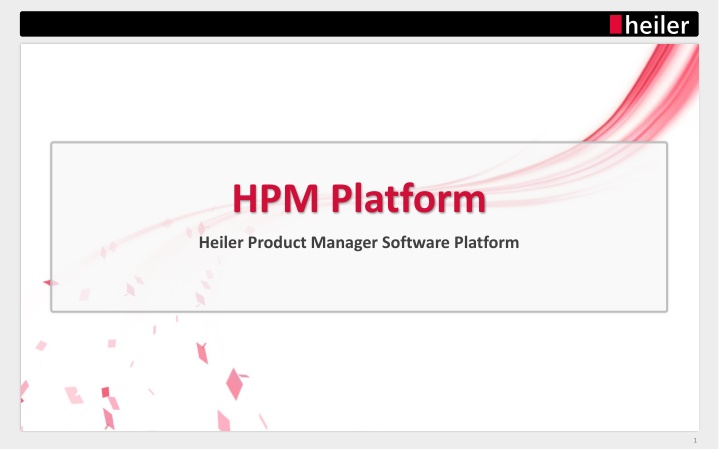
HPM Platform: A Comprehensive Overview
Discover the technical definition of HPM (Heiler Product Manager), a powerful Product Information Management (PIM) solution that allows for the import, storage, management, and export of product information. Explore the features, architecture, and functional layers of the HPM platform, which is a custom application server and client technology developed by Heiler Software AG over a decade ago. Learn about its extensibility, customization options, client-server communication framework, and more.
Download Presentation

Please find below an Image/Link to download the presentation.
The content on the website is provided AS IS for your information and personal use only. It may not be sold, licensed, or shared on other websites without obtaining consent from the author. If you encounter any issues during the download, it is possible that the publisher has removed the file from their server.
You are allowed to download the files provided on this website for personal or commercial use, subject to the condition that they are used lawfully. All files are the property of their respective owners.
The content on the website is provided AS IS for your information and personal use only. It may not be sold, licensed, or shared on other websites without obtaining consent from the author.
E N D
Presentation Transcript
HPM Platform Heiler Product Manager Software Platform 1
What is HPM (technical definition) Heiler Product Manager - Product Information Management (PIM) solution Is a client-server system used to import, store, manage and export information about products Provides rich user interfaces based on desktop client Provides integration interfaces with other systems Highly customizable on technical and business level Optimized for large data volumes HPM Platform 5.3 2
HPM Platform HPM platform is a custom application server and client technology developed by Heiler Software AG Uses Model-driven engineering concept Supports customizable business models Uses domain meta models in runtime as opposite to code generation approach Transparent client-server communication, shared services Provides all necessary components to build enterprise level data management applications Over 10 years old. Constantly evolving. Client side is based on Eclipse RCP and OSGi Rich GUI. Customizations of any kind Server side is based on OSGi technology with eclipse extension registry OSGi supports software components dependency management Extension registry provides infrastructure for customizings and plugins Client-server communication is based on a custom communication framework p2p communication bus Features: multi-server, load balancing, transparent client-server communication File name - Click Insert / Header & Footer to edit 3
HPM Platform the true challenge Is a base for different business and domain models Many layers of abstraction Extensibility and customization on all levels Complex data models Fat client A lot of public API API backward compatibility Running by many customers About 10 years old and counting File name - Click Insert / Header & Footer to edit 4
HPM Functional Layers HPM Application Business model: items, catalogs, classification structures, attributes, prices, descriptions etc.. Custom presentation logic. Business logic. HPM Platform Data access, application infrastructure, application services, Client GUI Data generic merge Data generic import Data generic export User tasks File name - Click Insert / Header & Footer to edit 5
HPM Platform layers Data management The core of the HPM platform. Provides business data objects lookup and modification services. Infrastructure services Cross-cutting frameworks and services required by all components (security, extension registry, communication framework, etc.) Application services Standard application services which can be used by business logic (jobs, workflows, webservices integration, etc) GUI Graphical user interface framework. Based on eclipse RCP platform. Very flexible and provides numerous extension points. File name - Click Insert / Header & Footer to edit 6
Platform components Domain model repository Data access engine Data Security Data navigation Data Search Command framework Data models Audit RCP (Eclipse) Communication bus I18N Preferences Domain model UI elements Caching XML Logging Workflow engine (JBPM) Lifecycle management serialization Servlet container Web-services integration Mass data processor Mail service Extensions framework (Eclipse) File transfer Job framework System jobs Security Monitoring App Logging Data layer Application services GUI Infrastructure File name - Click Insert / Header & Footer to edit 7
The HPM Architectural Principle Generic Import Logic Mapping from external data Domain Entity Data Domain Entity Data Domain model Any custom Generic Logic Domain Entity Data Structure Persistence meta data Any custom meta data New data management / access approach Generic Persistence Logic Validation meta data Security meta data Presentation meta data Query meta data Entity Data Presentation Render Generic UI Logic Storage Access data Domain Entity Data File name - Click Insert / Header & Footer to edit 8
The HPM Architectural Principle HPM application is built around domain model Domain model has a structure definition and is enriched with custom metadata Application functional layers are implemented in a generic way and can work with any domain model. Domain model is interpreted or processed in run-time using respective metadata. Advantages: Domain model structure can be changed without changing the logic New functional layers can be added without altering the existing ones File name - Click Insert / Header & Footer to edit 9
HPM Distributed Platform HPM Platform is distributed and supports multiple clients servers. HPM communication framework is a communication bus of the platform. Core is a part of the application and platform logic which is deployed on the server and client sides (shared logic). Client context Client Core Server Communication bus (HPM communication framework) Server context File name - Click Insert / Header & Footer to edit 10
HPM Platform technology stack Java 6 Apache commons OSGi equinox Quartz Eclipse RCP EHCache Eclipse Modeling Framework (EMF) Oracle 10g, 11g Service Data Objects (SDO) MS SQL Server 2005, 2008 Hibernate/JPA, JDBC Webservices (Axis2 , REST JAX-RS) JBPM (Workflows) Servlets (Jetty) File name - Click Insert / Header & Footer to edit 11
Platform components Data layer File name - Click Insert / Header & Footer to edit 12
Data layer (I) Domain model repository Defines domain model structure: entities, attributes, relations. Defines meta information needed for domain objects presentation, persistence, validation, audit, security. Defines types of logical filters (logical keys) for (sub)entity containers. Can be modified by non-developer. Is a run-time model - no code generation is performed using the model. Data models Detail model runtime container for a single business entity including its containments (sub-entities) List model read-only table container for large sets of business entities which data graphs are projected on table rows. Report internal structure which represents a set of business entities IDs, produced by search query. Entity Proxy identity object for business entities Data navigation Utility objects and services used to define navigation paths and filters on graphs of business entities Used in run-time by detail models and list models. Main elements: FieldPath, EntityPath, LogicalKey Audit Data modification audit. Can customized File name - Click Insert / Header & Footer to edit 13
Data layer (II) Data access engine Detail model objects operations: Create Read Update Delete (CRUD). List model objects loading Business entities change notifications Transparently works on client and server side (same interfaces) Command framework Pluggable framework which is used to edit business entities. Provides declarative extension points to hook any kinds of entity or entity fields modifications Extensions are contributes pro field or entity using identifiers from repository. Intended to be used for custom business logic implementations. Data Security Managed by Access Control Lists (ACL), Qualified Field Permissions, Action rights. Data Search 1. Entity search framework: provides search expressions framework which can be used to define search conditions using entity field paths. Search query result is a list of entities IDs which satisfy given logical search criteria. 2. Reporting framework: provides services to run predefined search queries in a form of a DB stored procedure. File name - Click Insert / Header & Footer to edit 14
Domain Model Repository meta model (EntityType) Standard entity relation model (graph structure). EntityType business entity. Do not let Type part mislead you, think about a EntityType as a business entity! EntityTypes contain FieldTypes. EntityTypes contain other entityTypes. EntityTypes which do not have parent EntityTypes are called root entityTypes (not shown on the diagram). EntityTypes which do have parent EntityTypes are called sub entityTypes (not shown on the diagram). FieldTypes may reference other root EntityTypes (one-to-many relation). Entity relation meta model: Example: File name - Click Insert / Header & Footer to edit 15
Domain Model Repository meta model (Runtime Elements) ProxyType defines identity object for EntityType. Proxy is a small lightweight object which contains values (ids) which uniquely identify business entity instance. ProxyType defines proxy java class and information how to instantiate proxy in run-time (references to fieldTypes) LogicalKeyType defines parameter type of logical filters in entityType containers Logical filter in the container constrict set of elements. You can think about it as a data dimension. For example imagine a list of article descriptions in different languages, here language id defines a language dimension. LogicalKey, which points to language id fieldType defines a logical filter parameter type. EntitType may have many different logical key and respectively many dimensions. File name - Click Insert / Header & Footer to edit 16
Domain Model Repository meta model (Entity) Repository entity element fa ade of the EntityType Entity delegates most of the business entity definition to EntityType Every business entity is represented by entity element in the repository Represents part of business entity definition which can be safely customized. Example: set entity I18N label Different entities may reference to the same EntityType Example: PurchasePrice and SellingPrice are different entities but reference to the same ArticlePriceType File name - Click Insert / Header & Footer to edit 17
Domain Model Repository meta model (Complete) Complete Repository 1 0..1 1 EntityType FieldType * 1 Types * 1 1 * 1 1 1 1 1 0..1 LogicalKeyType 1 1 * Repository ProxyType 1 0..* LogicalKey 1 * 0..* 0..* 1 0..1 Custom Entity Field * 1 1 * 1 1 1 1 * 1 1 1 PermisionCategory * Enumeration EnumEntry * Category 1 * 1 Permision Permissions * * 1 File name - Click Insert / Header & Footer to edit 18
Domain Model Repository meta model (other elements) Permissions Defines permission types for entities Enumerations Domain model enumerations. Example: country codes. Values can be hard-coded in the repository or populated in run-time using EnumerationValueProvider extensions. Categories For presentation only Categories are used to group entity fields in the UI. Logical keys for entities Defines logical keys for entity elements. References the LogicalKeytTypes. Logical key values can be hardcoded in the entity definition. In runtime it will work as a constant filter. File name - Click Insert / Header & Footer to edit 19
Attribute categories of the repository elements General attributes Identifiers, Data type, Object name Presentation I18N labels, documentation, UI elements references, UI label patterns Security Persistence Attributes used to map fields and entities data to DB persistence models Application Meta data for import, export, user tasks Constraints Field values constraints used by validation framework See repository documentation in SDK File name - Click Insert / Header & Footer to edit 20
Repository Repository is based on EMF technology and modeled using ECore model. Visual editor is available as a standalone application Repository model is stored in Repository.repository file in XML format. File name - Click Insert / Header & Footer to edit 21
Data navigation Generic navigation on entity data graphs in runtime Example: in the article data graph navigate to the article long description in English Navigation paths are defined on domain data model, but not on data instances. Used on many places across platform: presentation, persistence, business rules, etc Used by generic import and export modules to define data mappings Navigation paths defined by EntityPath and FieldPath in terms of repository elements EntityType and FieldType EntityPath has start EntityType and target EntityType FieldPath consists of EntityPath and pointer to repository FieldType 1:n relations in the EntityPath are resolved using logical keys To resolve ambiguity while navigating throw the container of elements you need to define values of logical keys of this container. Logical keys values shell be set on the enityPath object, it is called qualification. When all keys are set then entity path is full qualified. Example: path to article long description text in English. ArticleType -> (logicalKey.langugageId=7) -> ArticleLangData: LongDescriptionFieldType File name - Click Insert / Header & Footer to edit 22
Types of logical keys Key which is mapped to a business field and this field can only take values from a predefined set - enumeration (example: language id) Key which is mapped to a business field and a field value set is not predefined (example suppler id) Key which value is a (irreversible) function of other field values (example: valid at price field) Key mapped entity relation field (proxy field) Combinations of these types are also possible File name - Click Insert / Header & Footer to edit 23
Data models entity proxy Entity proxy is lightweight immutable object which contains entity unique identification data It is a reference to entity item. Used in all data access methods and frameworks Every root EntityType (and every Entity) has its own java implementation of a Proxy interface Proxies usually contain internal identifier (id in the DB) and external identifier (String) If only external identifier is set then the proxy is transient and may not represent existing item or represent entity which is not yet created. Starting from HPM 6.0: contains entity identifier Cached in memory and can be resolved only by internal id and data source (database identifier) Can be instantiated using EntityProxyFactory Factory uses meta info from repository to instantiate java entity proxy objects May contain parent entity proxy Parent type depends on proxy implementation, not on domain model structure! File name - Click Insert / Header & Footer to edit 24
Data models detail model Detail model is a container for root entity item data graph. It contains the actual entity data. Item data graph is a EMF based SDO object. Supports platform-wide change notification and caching. Single instance for each entity. On detail model save operations all clients and servers are notified. Supports transactions using read and write locks inside one JVM. Detail model and contained entity can be locked for writing while performing data change operations . Objects are locked only inside one JVM. Optimistic locking for several JVMs is used. Entity field values can be read using FieldPaths. Modifications shell be performed using Command Framework only. Detail model instances are managed using EntityManagers. Operations: load detail model by proxy, save, create new Entity models are cached to reduce number of load requests One entity manager instance pro EntityType defined in the repository. File name - Click Insert / Header & Footer to edit 25
Versioning Platform supports root entity versioning on the business level. Entity versioning support is activated in the repository. All main entities in the standard repository support versioning. Entity version is actually a entity branch (in SCM terms), but on business layer it is used only as a tag read only branch. Entity item may reference other items of the same version only (versions for the referenced items are automatically created if needed) Version meta information is stored in the Version business entity. Versions are referenced using VersionToken object version id. Predefined version tokens: VersionToken.NONE - versioning is not supported VersionToken.HEAD the main version TBD: how to create a revision File name - Click Insert / Header & Footer to edit 26
Data models list model List model is a read-only table container for large (millions of records) sets of business entities Every column in the table is defined by a qualified FieldPath. Every row is a flattened sub graph of a root entity. Supports transitions, i.e. references to other root entities in the data graph. Supports data virtual load (data lazy load) Unit (DE) EAN Description (EN) Unit (US) Rows are loaded in blocks and only when they are really requested by a API consumer. Items set can be defined by arbitrary list of ids. File name - Click Insert / Header & Footer to edit 27
Data models - report Report is a persisted list of ids of root entities. Used to define entity set in list models. Report can be created using following methods: 1. Execute HPM data search query (search expressions). 2. Executing a report query - predefined DB stored procedure. 3. Use existing array of ids Report operations : intersect, subtract, copy, delete. Reports are stored in the DB and are used to select data using SQL JOINs Reports can be temporary or permanent. Temporary reports are regularly deleted from DB (every hour). Since 5.3 it is recommend to use EntityItemSelection which wraps report and its id array. Before 6.0 reports are managed using ReportUtils. Since 6.0 only ReportService shell be used. File name - Click Insert / Header & Footer to edit 28
Datamodel report. JOIN Report is a persisted and reusable result of a SQL WHERE condition Report Storage: Select A ... ItemId ReportId 102432 101 Select B ... 10564 101 Select C ... 3426 101 JOIN 347445 101 33356 101 102 102 JOIN JOIN File name - Click Insert / Header & Footer to edit 29
Data access engine Access ListModel and DetailModel objects in the core contex (i.e. on server and client side) Autimatically synchronize data modificatios across clients and servers DetailModel data acccess cycle: 1. Create entity proxy using ProxyFactory or get proxy from list model row or use proxy lookup service (starting from 6.0) 2. Load detailModel by enityProxy (use sub entityfilters if necessary) 3. Lock detailModel 4. Perform data modifications using command framework 5. Save detailModel 6. Unlock detailModel Listmodel data access: 1. Create a report selection of the desired root entities 2. Create listmodel settings: qualifiedfields, load sytle (virtual/non-virtual), etc 3. Load data using listModel loader 4. Iterate over listmodel rows File name - Click Insert / Header & Footer to edit 30
Data access engine data synchronization Communication framework Core context Server context DetailModel Cache DetailModel change communication-events listeners Persistence Layer Notifies Change notification DetailModel change listeners EntityManager Notifies Entity Persistence Manager DataGraph handlers (communication) Update Lismodel (items < 3) Save DataGraph Load DataGraph Fragment framework Update Lismodel (items > 3) ListModel Synchronizer ListModel Load list model handler(communication) ListModel ListModel Loader File name - Click Insert / Header & Footer to edit 31
Data modification command framework Pluggable framework which is used to edit business entities and contribute custom data logic Provides several predefined workflows (called commands) for entity data modifications. PutCommand, CreateCommand, AddCommand, RemoveCommand Each command consists of operators (steps). Steps sequence and transision depends on command implementation. Initializer, property validator, preSetter, setter, postSetter, remover, etc. To customize commands (workflows) one can contribute operators for any repository Entiy, EntityType, Field or EntityFeild. In run-time one can supply different callbacks feedback processors. Feedback processor must react on validation warning/errors and fatal errors. Examples: UI feedback processor open warning dialog, logging feedback processor write warning into logfile Detailed documentation is available File name - Click Insert / Header & Footer to edit 32
Data modification command framework PutCommand [found=true] EntityFinder (operator) PutCommand.create( ) PutCommand.set( ) [found=false] PropertyInitializer (operator) CreateCommand (command) EntityFinder (operator) PropertyChangeChecker (operator) PropertyInitializer (operator) [destination not found] [change=true] PutCommand.put( ) PropertyValidator (operator) CreateCommand (command) PropertyValidator (operator) [performEntityValidation=true] PropertyPreSetter (operator) [false] PropertyPreSetter (operator) EntityValidator (operator) [destination found] PropertySetter (operator) EntityParentChildValidator (operator) [was found=false] [performEntityValidation=true] PropertySetter (operator) [change=false] PropertyPostSetter (operator) [performEntityValidation=false] EntityValidator (operator) EntityAdder (operator) PropertyPostSetter (operator) EntityParentChildValidator (operator) EntityAdder (operator) File name - Click Insert / Header & Footer to edit 33
Data security ACL, Field Pemissions, Action Rights Access Controll List (ACL) data access security for business object instances Implementaion has been inspired by java security Fine-grind: it is possible to define access permissions on a single business entity instance for a single user or group. Standard permissions avaialbe: FULL, DELETE, WRITE, READ Field permissions and qualified field permissions. Rights defined on the repository elements Action rights. Defines security rules for user UI actions. Used in CommandFramework , Persistence Layer, UI. File name - Click Insert / Header & Footer to edit 34
Data search Data search is used to find root entitys which sutisfy certain search createrias. Search result is usually backed by a report. First approach: reporting framework reports execution and management Provides mechanisms to run predefined stored procedures and store results as a report. Platform provides dozens of predefined stored procedures (i.e. search queries) It is possible to use another report as a filter for stored procedures Second approach: entity search framework search expressions and search query execution engine Generic framework to define logical search criterias in terms of EntityTypes, FieldTypes and logical keys. Search query language Can not search across different datasources (MAIN, MASTER, SUPPLIER) Search query definitions are persistable File name - Click Insert / Header & Footer to edit 35
Data Audit Platform provides hooks to audit data modifications EntityAuditLog - high level asynchronous interface (deprecated) Contributions are free to implement any kind of audit logic. Persistence is not supported by platform AuditLogProvider synchronous interface to prepare audit log records It is not audit log trail, i.e. it does not create modification history! AuditLogProvider implementations must create or update logRecord. It can be only one record pro entity! Platform provides persistence logic for audit log records. Implemented by AuditLogWriter Standard HPM AuditLogProvider Record creation, modification or deletion timestamp and user id Auditlog records are available in the business model File name - Click Insert / Header & Footer to edit 36
Main classes in the data access layer EntityProxy, EntityDetialModel, Listmodel, EntityProxyFactory, EntityManager, ListModelLoader, ListModelSettings, ListModelSynchronizer, EnumerationProvider ListEntry, ListColumn, ListEntry EntityPath, FieldPath, LogicalKey, Repository, RepositoryUtils, EntitType, FieldType Command, FeedbackProcessor, CommandContext Report, ReportResult, ReportQuery, ReportService EntityProperty, EntityItem, ListModelQuery, ListModelProvider, ListModelQuery,EntityItemList, LogicalKeyEvaluator, QualificationElement, QualificationModel, VersionProxy, VersionToken, EDataGraph File name - Click Insert / Header & Footer to edit 37
Infrastructure services File name - Click Insert / Header & Footer to edit 38
Infrastructure components Extensions framework I18N Communication framework DB access Components lifecycle management Caching Security and Authentication Logging Preferences and configuration Monitoring XML serialization Packaging File name - Click Insert / Header & Footer to edit 39
Extensions framework Eclipse extensions HPM Platform and application extension mechanism is based on eclipse extension framework Eclipse provides the concept of "extension points" and "extensions" to facilitate that functionality can be contributed to plugins by other plugins. Plugins which define extension points open themself up for other plugins. A extension points defines a contract how other plugins can contribute. A plugin which defines an "extension" contributes to the defined "extension point". Extensions to an extension points are defined in the plugins via the file "plugin.xml" using XML. Source: Eclipse Extension Points and Extensions by Lars Vogel (http://www.vogella.de/articles/EclipseExtensionPoint/article.html) File name - Click Insert / Header & Footer to edit 40
Extension points and extension contributions HPM Plugin B Eclipse Plugin G HPM Plugin A Extension Point B Extension Point A Extension Point G HPM Plugin D Extension Point F Extension Point D HPM Plugin C HPM Plugin E HPM Platform and application consists of plugins which contribute to some extension points and define own extension points. HPM Platform and application provide a large number of extension points Application developers can define new extension points File name - Click Insert / Header & Footer to edit 41
Extension point example communication request handler Extension point definition Extension point contribution File name - Click Insert / Header & Footer to edit 42
Working with extensions Extension registry can be programmatically accessed using IExtensionRegistry service Extension point creator is responsible for extension contributions initialization Using extensions one can contribute java classes (for example some listener class contribution) If a contributor class implements IExecutableExtension interface then it can access contribution attributes. File name - Click Insert / Header & Footer to edit 43
Working with extensions communication handler example <plugin> Extension contribution plugin.xml : <extension point="com.heiler.ppm.communication.core.requestHandlers"> <requestHandler typeSelector="com.heiler.ppm.std.core.message.ListModelLoader" class="com.heiler.ppm.std.server.internal.handler.ListModelLoader" name="Non-Virtual ListModel Loader"/> </extension> </plugin> Extension initialization: //get extension registry using eclipse platform singletone IExtensionRegistry reg = Platform.getExtensionRegistry(); IExtensionPoint extPoint = reg.getExtensionPoint( "com.heiler.ppm.communication.core.requestHandlers" ); IExtension[] extensions = extPoint.getExtensions(); IConfigurationElement[] elems = extensions[ 0 ].getConfigurationElements(); IConfigurationElement configElement = elems[ 0 ]; //Instantiate class contribution RequestHandler handler = ( RequestHandler ) configElement.createExecutableExtension( "class" ); String selectorId = configElement.getAttribute( "typeSelector" ); File name - Click Insert / Header & Footer to edit 44
Communication bus HPM communication framework Custom communication framework One node may have many roles simultaneously Multiple servers with different roles Node roles: Client client only, cannot accept requests Load balancing, failover Client server dispatch requests from clients Primary/secondary controller shared services for all nodes Logical P2P network Job server server for batch jobs File server file storage server Node client Node client Node client Node client Node client Network Node job server Node Node Node client server Node file server primary controller secondary controller File name - Click Insert / Header & Footer to edit 45
Communication flows Parties Service invoker synchronously sends a message and receives a response Communication is message based Node - marshal, route, enqueue and dispatch messages Request handler gets the message and handles the service logic Event producer asynchronously sends (broadcast) messages Event handler receives event and handle the listener logic Communication bus Request handler Service invoker Request-response messages (sync) Handle message Send message Node Node Event messages (async broadcast) Event producer Node Event handler Event handler File name - Click Insert / Header & Footer to edit 46
Communication send a message // Build the request message EasyMapMessage msg = new EasyMapMessage( "com.heiler.ppm.configuration.server.message.GetServerPreference" ); msg.put( "pluginId", pluginId ); msg.put( "preferenceId", preferenceId ); msg.put( "defaultValue", defaultValue ); // Send the request try { String value = ( String ) TheNode.getNode().sendRequest( NodeIdentifier.SERVER, msg ); return value; } catch ( CommunicationException e ) { log.error( e.getLocalizedMessage(), e ); } File name - Click Insert / Header & Footer to edit 47
Communication handle a message public class GetServerPreference implements RequestHandler { public Object onMessage( RequestContext context, Message msg ) throws CoreException, InterruptedException { EasyMapMessage message = ( EasyMapMessage ) msg; String preferenceId = message.getString( "preferenceId" ); //$NON-NLS-1$ String defaultValue = message.getString( "defaultValue" ); //$NON-NLS-1$ IPreferencesService service = Platform.getPreferencesService(); String value = service.getString( pluginId, preferenceId, defaultValue, null ); return value; } } <plugin> <extension point="com.heiler.ppm.communication.core.requestHandlers"> <requestHandler class="com.heiler.ppm.configuration.server.handler.GetServerPreference" name="Get Server Preference" singleton="false" typeSelector="com.heiler.ppm.configuration.server.message.GetServerPreference"/> </extension> </plugin> File name - Click Insert / Header & Footer to edit 48
Communication main classes TheNode platform singleton, holds the node instance Node communication node interface NodeInfo node runtime descriptor (identifier, roles, etc.) NodeIdentifier node identifier descriptor Network HPM logical network runtime descriptor (servers, clients, etc) NodeListener communication interceptor (request/response interceptor) RequestHandler request handler interface Message and EasyMapMessage message interfaces EventListener event listener interface File name - Click Insert / Header & Footer to edit 49
Components lifecycle management HPM platform is using OSGi mechanisms to manage components dependencies and versions OSGi bundle activators are NOT used (start() method is empty) Platform services are initialized and started using Initializers Initializers are called on startup by a PlatformContainer. Sequence is defined by RunLevel attribute of the contribution. Initializer has also a counterpart Disposer. Disposer is executed on shutdown. <extension point="com.heiler.ppm.init.core.initializers"> <initializer class="com.heiler.ppm.repository.internal.RepositoryValidator" id="validate.repository" start-level="PLATFORM_5"> </initializer> </extension> File name - Click Insert / Header & Footer to edit 50




